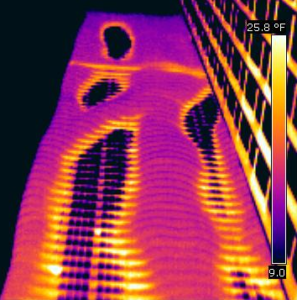We have said many things about taking advantage of this wonderful piece of technology in our every day lives. If you don’t have an idea of what I’m talking about or you are new, go here. The point is we discussed about people using it in their private professional lives, such as someone who is trying to find the termites behind the wall or perhaps someone looking to place insulation a new home and isn’t sure of the amount to knock out a great part of the outside temperatures. Also it was discussed that the use of infrared thermal imaging could be applied in fire departments, when firefighters would go into flaming buildings.

In this article, I want to talk about the use of the infrared thermal imaging technology in roofing and contractors that are responsible for roof installations or roof repairs. I didn’t know anything about this to be honest, however I read a blog the other day from a roofer talking about his new advanced roof detection techniques and methods, and one of those were the use of infrared thermal imaging. Feel free to visit his site: http://www.roofingcolumbia.org
As I’ve said before, these professionals that agree of the necessity of this technology, are probably the best in your market. Because if they care so much about new technology and things that will make them better in their job, you know you have a good roofer that will watch out for any issues on your roof. I know what most of you will wonder how exactly can infrared thermal imaging help a roofer out. If you were paying attention to the blogs you would get into the spirit of this all.
So a roofer, many times will be called by the home owner because they are having a leak from their roof. Very common situation: people start noticing water dripping in the middle of the kitchen, and they know something is wrong. If the leak is big enough and you can identify the source and area where it’s coming from, then the roofer can come in and find that hole and repair it. Many times however, leaks aren’t being detected because they aren’t that big. Or the leaks can be behind a wall and you won’t understand you have a problem until you start smelling the moldy water. So infrared thermal imaging, can help so you find those water stains that will appear in the thermal camera. If I had a picture right now for you, you would see the water as lines being created by those drops, in a blue color. Not only that, but the roofer can actually point the camera at the sealing and there where he sees different temperature coming in, he knows there is a weak part of the roof.
For instance: he points the camera at the sealing and finds the different temperatures entering the room: there where you see hotter air entering (if it’s during the summer time) you know that you have a small whole that you need to repair from above. Why is this useful? The hole may be small and the problem may not be that big, however if you allow that to “grow” it will become a bigger problem for the homeowner in the future. First of all, if you allow water to come in, it will ruin your wood and sheet rock walls. In terms of temperature, if you are running your air conditioner and you are losing a part of that cold air because of a leak, you are spending money for no extra reason. But besides that, if you let the problem become bigger it will cost you a lot more money to fix. So you wan’t to try and solve the issue at the very beginning so you have the smallest expense possible. Identifying the problem in its early stages, will also help you stay protected. If your roof is becoming weaker and can’t support a lot of weight on top, you are risking the junk on the outside (like branches etc) to fall through into your home, damaging interiors and also yourself if you happen to be there at that time.
So there are so many applications just for the roofing business alone. I tell you guys: infrared thermal imaging is the future!
Thank you for reading, I’ll catch you all later!
Aaron